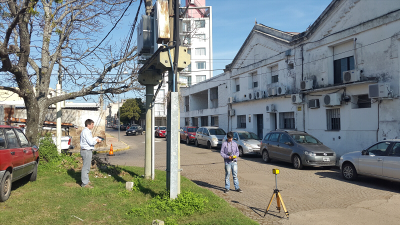Environmental monitoring
In order to provide a comprehensive service and ensure the collection of primary data, we have developed conventional and non-conventional environmental monitoring capabilities, covering the most varied needs of our customers.
We have our own instrument laboratory for the measurement of gaseous emissions and air quality under EPA Standards, and ENRE qualified personnel. We can evaluate gases in internal environments and ventilation systems. Our capabilities include the instrumental assessment of odors.
We have equipment and personnel to perform quality monitoring of surface waters (rivers, lakes and seacoast), groundwater, liquid effluents, noise, vibration and electromagnetic fields.
For special or infrequent projects, such as in the nuclear industry, we even develop new methodologies and monitoring equipment to ensure the quality of results.
Air Quality
- Combustion gases: CO, NO, NO2, NOx, SO2
- Respirable particulate material: PM10 y PM2,5
- Hydrogen sulfide and methane
- Non-methane hydrocarbons
- VOCs and semiVocs. Organic Vapors
- Sedimentable particulate material
- Indoor air quality
- Gases occluded in the subsoil and in buildings
Gaseous emissions
- Combustion gases: CO, NO, NO2, NOx, SO2, O2 y CO2
- Particulate matter
- Dioxins and Furans
- VOCs y semiVocs. Organic Vapors
- Thermodynamic Parameters
Odors
- Individual trace level gases
- Organoleptic evaluation
- Sources of odor and external propagation
- Zonal evaluation using diffusion models
- Local CFD Rating
Surface water
- Physical parameters, on-site monitoring
- Chemical Contaminants
- Biological parameters: Plankton, benthos, macro organisms
- Flow velocity, current lines and bathymetry
- Thermal stratification and vertical distribution of dissolved oxygen
- Organic load and nutrients
Groundwater
- Static level, water table maps
- Recovery tests, water potential assessment
- Sampling of thermometers and piezometers
- Analysis of production wells
- Physical parameters, on-site monitoring
Noise and vibration
- Perimeter and environmental noise
- Assessment of annoying neighborhood noises
- Indoor noise
- Sources of noise and vibration
- Noise maps
- Vibrations transmitted abroad
- Cosmetic vibration impact
Soils and sediments
- Surface and subsurface soils
- Subsoil: borehole perforations and paving stones
- Subsoil: deep drilling with dry methods
- Sediments in industrial, urban and natural lagoons
- Sediments in rivers and seacoast
- Substrate and cover under buildings, urban areas

Non-ionizing radiation
- Magnetic field
- Electric field
- Profiles of Transformer Stations
- Impact of power lines
Radiological monitoring
- Special sampling for the evaluation of tritium and radionuclides
- Ambient air, rainwater, soil
- Surface waters and sediments: rivers and lakes
- Groundwater
- Flora and fauna in terrestrial and aquatic environments
- Development of techniques and special sampling elements